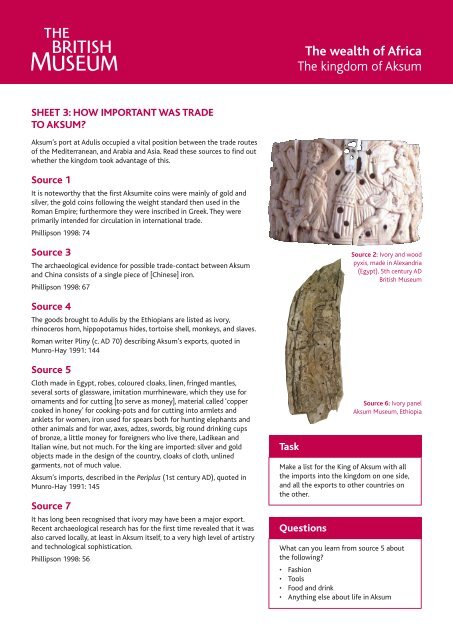The wealth of Africa The kingdom of Aksum - British Museum
The wealth of Africa The kingdom of Aksum - British Museum
The wealth of Africa The kingdom of Aksum - British Museum
Create successful ePaper yourself
Turn your PDF publications into a flip-book with our unique Google optimized e-Paper software.
SHEET 3: HOW IMPORTANT WAS TRADE<br />
TO AKSUM?<br />
<strong>Aksum</strong>’s port at Adulis occupied a vital position between the trade routes<br />
<strong>of</strong> the Mediterranean, and Arabia and Asia. Read these sources to find out<br />
whether the <strong>kingdom</strong> took advantage <strong>of</strong> this.<br />
Source 1<br />
It is noteworthy that the first <strong>Aksum</strong>ite coins were mainly <strong>of</strong> gold and<br />
silver, the gold coins following the weight standard then used in the<br />
Roman Empire; furthermore they were inscribed in Greek. <strong>The</strong>y were<br />
primarily intended for circulation in international trade.<br />
Phillipson 1998: 74<br />
Source 3<br />
<strong>The</strong> archaeological evidence for possible trade-contact between <strong>Aksum</strong><br />
and China consists <strong>of</strong> a single piece <strong>of</strong> [Chinese] iron.<br />
Phillipson 1998: 67<br />
Source 4<br />
<strong>The</strong> goods brought to Adulis by the Ethiopians are listed as ivory,<br />
rhinoceros horn, hippopotamus hides, tortoise shell, monkeys, and slaves.<br />
Roman writer Pliny (c. AD 70) describing <strong>Aksum</strong>’s exports, quoted in<br />
Munro-Hay 1991: 144<br />
Source 5<br />
Cloth made in Egypt, robes, coloured cloaks, linen, fringed mantles,<br />
several sorts <strong>of</strong> glassware, imitation murrhineware, which they use for<br />
ornaments and for cutting [to serve as money], material called ‘copper<br />
cooked in honey’ for cooking-pots and for cutting into armlets and<br />
anklets for women, iron used for spears both for hunting elephants and<br />
other animals and for war, axes, adzes, swords, big round drinking cups<br />
<strong>of</strong> bronze, a little money for foreigners who live there, Ladikean and<br />
Italian wine, but not much. For the king are imported: silver and gold<br />
objects made in the design <strong>of</strong> the country, cloaks <strong>of</strong> cloth, unlined<br />
garments, not <strong>of</strong> much value.<br />
<strong>Aksum</strong>’s imports, described in the Periplus (1st century AD), quoted in<br />
Munro-Hay 1991: 145<br />
Source 7<br />
It has long been recognised that ivory may have been a major export.<br />
Recent archaeological research has for the first time revealed that it was<br />
also carved locally, at least in <strong>Aksum</strong> itself, to a very high level <strong>of</strong> artistry<br />
and technological sophistication.<br />
Phillipson 1998: 56<br />
Task<br />
<strong>The</strong> <strong>wealth</strong> <strong>of</strong> <strong>Africa</strong><br />
<strong>The</strong> <strong>kingdom</strong> <strong>of</strong> <strong>Aksum</strong><br />
Source 2: Ivory and wood<br />
pyxis, made in Alexandria<br />
(Egypt), 5th century AD<br />
<strong>British</strong> <strong>Museum</strong><br />
Source 6: Ivory panel<br />
<strong>Aksum</strong> <strong>Museum</strong>, Ethiopia<br />
Make a list for the King <strong>of</strong> <strong>Aksum</strong> with all<br />
the imports into the <strong>kingdom</strong> on one side,<br />
and all the exports to other countries on<br />
the other.<br />
Questions<br />
What can you learn from source 5 about<br />
the following?<br />
• Fashion<br />
• Tools<br />
• Food and drink<br />
• Anything else about life in <strong>Aksum</strong>

















